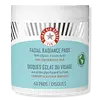What's inside
What's inside
 Key Ingredients
Key Ingredients

 Benefits
Benefits

 Concerns
Concerns

 Ingredients Side-by-side
Ingredients Side-by-side

Water
Skin ConditioningAloe Barbadensis Leaf Juice
Skin ConditioningGlycerin
HumectantCucumis Sativus Fruit Extract
EmollientLactic Acid
BufferingGlycolic Acid
BufferingLeuconostoc/Radish Root Ferment Filtrate
AntimicrobialChrysanthemum Parthenium Extract
Skin ConditioningSodium Hydroxide
BufferingPolysorbate 20
EmulsifyingCamellia Sinensis Leaf Extract
AntimicrobialGlycyrrhiza Glabra Root Extract
BleachingCitrus Nobilis Fruit Extract
MaskingCitrus Limon Peel Extract
EmollientHyaluronic Acid
HumectantPhyllanthus Emblica Fruit Extract
HumectantEDTA
Tetrasodium EDTA
Phenoxyethanol
PreservativeChlorphenesin
AntimicrobialWater, Aloe Barbadensis Leaf Juice, Glycerin, Cucumis Sativus Fruit Extract, Lactic Acid, Glycolic Acid, Leuconostoc/Radish Root Ferment Filtrate, Chrysanthemum Parthenium Extract, Sodium Hydroxide, Polysorbate 20, Camellia Sinensis Leaf Extract, Glycyrrhiza Glabra Root Extract, Citrus Nobilis Fruit Extract, Citrus Limon Peel Extract, Hyaluronic Acid, Phyllanthus Emblica Fruit Extract, EDTA, Tetrasodium EDTA, Phenoxyethanol, Chlorphenesin
 Reviews
Reviews

Ingredients Explained
These ingredients are found in both products.
Ingredients higher up in an ingredient list are typically present in a larger amount.
Glycerin is already naturally found in your skin. It helps moisturize and protect your skin.
A study from 2016 found glycerin to be more effective as a humectant than AHAs and hyaluronic acid.
As a humectant, it helps the skin stay hydrated by pulling moisture to your skin. The low molecular weight of glycerin allows it to pull moisture into the deeper layers of your skin.
Hydrated skin improves your skin barrier; Your skin barrier helps protect against irritants and bacteria.
Glycerin has also been found to have antimicrobial and antiviral properties. Due to these properties, glycerin is often used in wound and burn treatments.
In cosmetics, glycerin is usually derived from plants such as soybean or palm. However, it can also be sourced from animals, such as tallow or animal fat.
This ingredient is organic, colorless, odorless, and non-toxic.
Glycerin is the name for this ingredient in American English. British English uses Glycerol/Glycerine.
Learn more about GlycerinPhenoxyethanol is a preservative that has germicide, antimicrobial, and aromatic properties. Studies show that phenoxyethanol can prevent microbial growth. By itself, it has a scent that is similar to that of a rose.
It's often used in formulations along with Caprylyl Glycol to preserve the shelf life of products.
Sodium Hydroxide is also known as lye or caustic soda. It is used to adjust the pH of products; many ingredients require a specific pH to be effective.
In small amounts, sodium hydroxide is considered safe to use. However, large amounts may cause chemical burns due to its high alkaline.
Your skin has a natural pH and acid mantle. This acid mantle helps prevent harmful bacteria from breaking through. The acid mantle also helps keep your skin hydrated.
"Alkaline" refers to a high pH level. A low pH level would be considered acidic.
Learn more about Sodium HydroxideWater. It's the most common cosmetic ingredient of all. You'll usually see it at the top of ingredient lists, meaning that it makes up the largest part of the product.
So why is it so popular? Water most often acts as a solvent - this means that it helps dissolve other ingredients into the formulation.
You'll also recognize water as that liquid we all need to stay alive. If you see this, drink a glass of water. Stay hydrated!
Learn more about Water